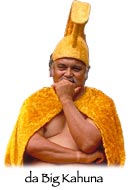Ask the Big Kahuna
“Answering the most common visitor questions”
Question:
A relative who just got back from Hawaii has been trying to tell us about an ancient Hawaiian game that you play with black and white rocks. She must have got something confused because no matter how she tried to show how it’s played or set up the board, she could never get the thing started. It’s supposed to be simple. She is from the wife’s side of the family, which goes a long ways to explain. I told her you’d know, so don’t make me out a liar!
Kenneth
Pocatello, Idaho

Response:
Aloha Kenneth,
Mahalo for sending your question to the Big Kahuna. I think I’ve got an answer for you.
Hawaiians call the game Konane, and it goes way back. King Kamehameha the Great was said to be brilliant at it.
In ancient days, the game board was a huge, flat-top rock usually near the water. The board rock, called papamu or papa konane has indentations where the stones lie in rows and columns. The layout is always square, and you can set as many places as you want as long as the number of rows and columns is the same.
Set up the board by placing a line of white stones across the longest diagonal starting at the bottom left. In the next line of diagonals on both sides of the white ones place black stones. The next diagonals are white stones. Then black. Continue until all diagonals are full. When you finish, you’ll have an entire board of alternating black and white stones.
One player removes two stones – one of each color – from anywhere on the board and hides them in his/her fists. The opponent selects a hand and plays with the color of the stone found there. Who goes first is variously determined. In some rules, it’s always black. In others, it’s the player who chooses the hand.
The game proceeds in a deceptively simple manner. Alternating turns, each player moves by jumping (‘eating’ in the Hawaiian language) an opponent’s stone and landing in an unoccupied space. No diagonal jumping. Double jumps are allowed if the spaces are there – like in checkers but only in one direction – row or column.
The last player who is able to move wins!
The best games are ones played on a beach in Hawaii, so practice at home but make plans to visit.
Big Kahuna